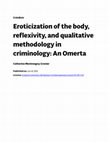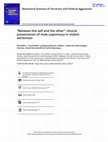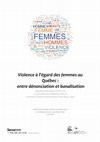Thesis Chapters by Catherine Montmagny Grenier

Within the field of criminology, the ecological perspective argues for an implicit notion of spat... more Within the field of criminology, the ecological perspective argues for an implicit notion of spatiality, one which reduces the physical environment to nothing more than a basic geographical site, thereby excluding the power relationships, as well as the social and cultural dynamics, or values- and meaning-based dynamics, conveyed therein. As such, this study investigates the importance of geographical space in criminology. By employing the concept of liminality, defined as a symbolic space-time, this thesis also specifically studies the role space plays in the (re)production of both illegalisms and playful deviance, their respective regulation, as well as in the production of knowledge. In order to shed light on the liminality concept, this thesis draws on a five-and-a-half-month-long ethnography, carried out in two Costa Rican beach towns. It also illustrates how the tourism industry’s neoliberal practices produce a liminal space that caters to quests for the exoticism, and especially the hedonism and authenticity, sought by tourists seeking to escape the confines of their everyday lives. While a segment of the scientific literature views liminality as a space where everyday norms are suspended, this thesis instead suggests that tourists adhere to norms already present in such spaces, ones specifically based on an aggressive form of hedonism, which in turn result in “out of the ordinary” alcohol and drug consumption, as well as sexuality, on the part of tourists. In adopting an interdisciplinary approach, this study initially employs cultural geography’s notion of space. This conception of space, which employs an idealist-materialist dialectic, also allows for the adoption of an analytical perspective based on the concept of uneven development. It also makes it possible to understand not only why certain places, regions, and countries are recognized as being so-called liminal spaces, but also how the practices of a capitalist economy push them to rely on an image of liminality in order to survive and operate within the market economy. In additionally taking inspiration from social anthropology, this thesis views the touristic experience as a rite of passage, while also proposing that tourists are subjected to a symbolic device, which leads them to perform a site-specific tourist identity. This performance, given concrete form by the consumption of transgressions, results in the (re)production of the liminal space. The thesis also shows that this symbolic device is a regulating mechanism in regard to conducts, but additionally to bodies. Lastly, the thesis illustrates the ways in which the research field is also a liminality for researchers, one which affects them, as well as the knowledge produced therein.
Papers by Catherine Montmagny Grenier

This article reflects upon the notion of reflexivity in qualitative methodology, both generally, ... more This article reflects upon the notion of reflexivity in qualitative methodology, both generally, and specifically within the field of criminology. This reflection stems from the completion of my pre-field research in Costa Rica, which I undertook during the realization of my doctoral thesis regarding the sexuality of solo female travelers. Based on a sexual assault I experienced during this pre-field research, I critically discuss the notion of reflexivity in cases where the security of researchers is undermined by the relations of power that exist between gatekeepers and participants as a result of gender identity and the eroticization of the body. This article specifically questions the space assigned to researchers and their bodies in the reflexive process that occurs during fieldwork. We were allowed to play with their words, their ideas, their culture as long as we pretended we were men. As soon as our cunts bobbed into the light of day, they stiffened, their lips tautened, they seemed to draw themselves into themselves; they cut us down. It was better not to try. One part of ourselves mocked another. We joined in their ridicule of our own aspirations. Either you played their game or you didn't play at all.
International Journal of the Sociology of Leisure, Nov 2, 2020
Based on a five-and-a-half month ethnography in two Costa Rican beach towns, this article seeks t... more Based on a five-and-a-half month ethnography in two Costa Rican beach towns, this article seeks to explain the drug consumption that occurs during touristic experiences by reworking the crime-consumerism nexus framework. Employing an uneven development perspective, it explains why drug consumption occurring within touristic contexts is under-policed and instead treated as privileged playful deviance. In doing so, the article demonstrates how the politics of the night-time economy (NTE) specific to the tourism industry shape the touristic destination into a liminal space that facilitates, encourages, and sustains drug consumption. The article provides new theoretical insights into the criminology of touristic spaces, the NTE, and playful deviance.

Behavioral Sciences of Terrorism and Political Aggression
This paper examines the relationship between gender and violent extremism (VE) among individuals ... more This paper examines the relationship between gender and violent extremism (VE) among individuals engaged in VE clinical services in Montreal, Quebec (Canada). We use mixed methods to understand the experiences and characteristics of individuals who express support for male supremacist ideologies. Study participants include 86 patients enrolled in VE clinical services and 7 clinical practitioners providing services. We conduct a retrospective chart review to identify clinical and sociodemographic characteristics of male supremacists. A focus group was conducted with members of the clinical team. Integrating quantitative and qualitative findings provides an opportunity to draw meta-inferences on male supremacist violent extremists, including a typology of the phenomena as well as clinical characteristics and social dynamics. Clinicians articulated that many of the harmful attitudes and beliefs of male supremacists were not marginal, but rather reflected in everyday forms of misogyny, homophobia and transphobia that were activated by their personal experiences. Our findings suggest the importance of clinicians remaining attentive to the underlying gendered grievances which shape a range of extremist beliefs. Finally, we explore the value of training practitioners who work on VE on diverse domains of gendered violence which may intersect with VE participation.

Behavioral Sciences of Terrorism and Political Aggression, 2023
This paper examines the relationship between gender and violent
extremism (VE) among individuals ... more This paper examines the relationship between gender and violent
extremism (VE) among individuals engaged in VE clinical services
in Montreal, Quebec (Canada). We use mixed methods to
understand the experiences and characteristics of individuals who
express support for male supremacist ideologies. Study
participants include 86 patients enrolled in VE clinical services
and 7 clinical practitioners providing services. We conduct a
retrospective chart review to identify clinical and
sociodemographic characteristics of male supremacists. A focus
group was conducted with members of the clinical team.
Integrating quantitative and qualitative findings provides an
opportunity to draw meta-inferences on male supremacist violent
extremists, including a typology of the phenomena as well as
clinical characteristics and social dynamics. Clinicians articulated
that many of the harmful attitudes and beliefs of male
supremacists were not marginal, but rather reflected in everyday
forms of misogyny, homophobia, and transphobia that were
activated by their personal experiences. Our findings suggest the
importance of clinicians remaining attentive to the underlying
gendered grievances which shape a range of extremist beliefs.
Finally, we explore the value of training practitioners who work
on VE on diverse domains of gendered violence which may
intersect with VE participation.

policy brief, 2022
Reposant sur une analyse critique du discours assisté par corpus, le présent mémoire de recherche... more Reposant sur une analyse critique du discours assisté par corpus, le présent mémoire de recherche montre comment le mot féminicide est traité dans l’espace social virtuel québécois depuis l’année 2019. Ce faisant, il vise à mettre en lumière les éléments qui alimentent, véhiculent et (re)produisent les discours d’un sexisme ordinaire qui peut, à son tour, banaliser - voire légitimer - d’autres formes de violence (physique, sexuelle, psychologique) à l’égard des femmes. En voici les grandes lignes : 1) L’utilisation du mot féminicide fait débat : il est chargé politiquement. À quoi réfère-t-il ? Avons-nous réellement besoin de ce mot ?; −2) Les féminicides rapportés dans les médias à l’étude évoquent plusieurs émotions et sentiments chez les lecteurs et lectrices : tristesse, peur, colère, sympathie, empathie, étonnement et résilience; 3) La notion de responsabilité, au sens large, est au cœur des échanges. Les discussions
portent sur la responsabilité même de la victime, le système de l’immigration, le système de justice canadien, le manque de ressource en matière de prévention et de santé mentale et le rôle de catalyseur qu’a joué la pandémie.

La perspective écologique qui s'est développée en criminologie adopte une notion implicite de la ... more La perspective écologique qui s'est développée en criminologie adopte une notion implicite de la spatialité qui réduit l'environnement à un simple site géographique et exclut les rapports de pouvoir, les dynamiques sociales et culturelles ainsi que les valeurs qui y sont véhiculées. La présente étude interroge donc l'importance de l'espace géographique en criminologie. Elle se penche particulièrement sur le rôle de l'espace dans la (re)production et la régulation d'illégalismes et de déviance ludique ainsi que sur la production du savoir par le biais du concept de liminalité compris comme un espace-temps symbolique. Pour exposer le concept de liminalité, la thèse repose sur une ethnographie de 5 mois et demi réalisée dans deux villes balnéaires du Costa Rica. Elle montre comment les pratiques néolibérales de l'industrie touristique créent un espace liminaire qui répond aux quêtes d'exotisme, mais surtout de sens et d'authenticité recherchées par les touristes qui souhaitent rompre avec leur vie quotidienne. Alors qu'un pan de la littérature scientifique considère la liminalité comme un espace où les normes quotidiennes sont suspendues, cette thèse suggère que les touristes adhèrent aux normes présentes dans cet espace, soit à celles qui reposent spécifiquement sur la consommation d'un hédonisme agressif. Cela les mène à une consommation d'alcool et de drogues ainsi qu'à une sexualité dites hors de l'ordinaire. S'inscrivant dans une approche interdisciplinaire, cette étude emprunte, dans un premier temps, la notion d'espace à la géographie culturelle. Cette conception de l'espace qui comprend une dialectique idéaliste-matérialiste permet d'adopter une perspective analytique de développement inégal. Celle-ci permet de comprendre non seulement pourquoi certains endroits, lieux, régions et pays sont connus pour être des espaces dits liminaires, mais également en quoi les pratiques d'une économie capitaliste poussent ceux-ci à miser sur une image de liminalité pour (sur)vivre dans l'économie de marché. Inspirée dans un deuxième temps par l'anthropologie sociale, la thèse considère l'expérience touristique comme un rite de passage et propose que les touristes soient soumis.es à un dispositif symbolique qui les mène à performer in situ une identité de touriste. Cette performance, concrétisée par la consommation de transgressions, a pour conséquence de (re)produire l'espace liminaire. La thèse montre également que ce dispositif symbolique est un mécanisme de régulation non seulement des conduites, mais aussi des corps. Enfin, la thèse indique que le terrain de recherche est également une liminalité pour les chercheur.ses qui les affecte ainsi que le savoir produit.
International Criminal Justice Review, 2014
The World Homicide Survey is a project that aims at gathering new data pertaining to violence and... more The World Homicide Survey is a project that aims at gathering new data pertaining to violence and homicide on most countries of the world. Using expert opinion, we measure perceptions of crime precipitators (firearms and organized crime) and the efficacy of justice agencies (police, courts, prisons, and corruption). To date, we have collected data from 366 respondents from 93 different countries. In this article, we report on our research strategy as well as preliminary analyses that address the question of the construct validity of our data. We also show how our new data correlate with the homicide rate of countries.
International Journal of the Sociology of Leisure, 2020
This article reflects upon the notion of reflexivity in qualitative methodology, both generally a... more This article reflects upon the notion of reflexivity in qualitative methodology, both generally and specifically within the field of criminology. This reflection stems from completing my pre-field research in Costa Rica, which I undertook while completing my doctoral thesis regarding the sexuality of solo female travelers. Based on a sexual assault I experienced during this pre-field research, I critically discuss the notion of reflexivity in cases where the security of researchers is undermined by the relations of power that exist between gatekeepers and participants as a result of gender identity and the eroticization of the body. This article specifically questions the space assigned to researchers and their bodies in the reflexive process that occurs during fieldwork.

Il a ete montre que l’Homme a un penchant latent a poser des gestes prohibes qui sont controles p... more Il a ete montre que l’Homme a un penchant latent a poser des gestes prohibes qui sont controles par les normes formelles et informelles de sa communaute. Si nous sortons un individu de sa communaute sera-t-il plus enclin a poser ces gestes? C’est cette situation que le present memoire cherche a exposer. Nous visons a comprendre le processus menant a la consommation de services sexuels remuneres dans un contexte touristique a l’etranger par l’etude du tourisme sexuel au Mexique. Nous cherchons a definir les facteurs qui motivent, ou du moins favorisent ce type de consommation dans un tel contexte. Pour rendre compte de ces facteurs, nous utilisons un corpus de donnees compose de commentaires publies par des touristes sexuels sur un forum de clavardage, se trouvant sur la Toile, et de donnees existantes. Nous analysons ce corpus de donnees par une combinaison theorique de l’intersectionnalite et du controle social. Precisement, nous analysons les commentaires seuls afin de rendre comp...
International Journal of the Sociology of Leisure, 2020
Based on a five-and-a-half month ethnography in two Costa Rican beach towns, this article seeks t... more Based on a five-and-a-half month ethnography in two Costa Rican beach towns, this article seeks to explain the drug consumption that occurs during touristic experiences by reworking the crime-consumerism nexus framework. Employing an uneven development perspective, it explains why drug consumption occurring within touristic contexts is under-policed and instead treated as privileged playful deviance. In doing
so, the article demonstrates how the politics of the night-time economy (NTE) specific to the tourism industry shape the touristic destination into a liminal space that facilitates, encourages, and sustains drug consumption. The article provides new theoretical insights into the criminology of touristic spaces, the NTE, and playful deviance.

Criminologie, 2015
La question du profilage est régulièrement soulevée lorsqu’il est question d’intervention policiè... more La question du profilage est régulièrement soulevée lorsqu’il est question d’intervention policière. Plusieurs analyses ont en effet conclu que certains groupes de personnes, comme les Noirs et les hommes, étaient surreprésentés parmi les individus arrêtés ou interpellés par la police. Les travaux de Steffensmeier et ses collègues ont démontré que la situation pouvait être encore plus complexe : ils ont proposé que certaines caractéristiques individuelles interagissent entre elles et que leur effet sur la sévérité des acteurs du système judiciaire soit multiplicatif plutôt qu’additif. Cette étude vise à tester l’effet d’interaction entre le sexe et l’origine ethnique, deux composantes visibles de l’identité d’un individu. Plus spécifiquement, l’étude porte sur la décision de recourir à des mesures extrajudiciaires à l’endroit d’adolescents ayant commis des vols simples de moins de 200 dollars dans une grande ville canadienne, comme le permet la Loi sur le système de justice pénale pour les adolescents (LSJPA) (n = 1647 décisions). Les résultats indiquent que les garçons non blancs sont de 1,7 à 2,0 fois moins susceptibles que les autres de bénéficier de mesures extrajudiciaires, à infraction similaire. Les trois autres groupes (garçons blancs, filles blanches, filles non blanches) ne se distinguent pas entre eux. En conclusion, l’analyse suggère que ces pratiques ne découleraient pas tant de la malveillance des policiers que de directives favorisant l’arrestation d’une plus grande proportion de garçons non blancs.
The World Homicide Survey is a project that aims at gathering new data pertaining to violence and... more The World Homicide Survey is a project that aims at gathering new data pertaining to violence and homicide on most countries of the world. Using expert opinion, we measure perceptions of crime precipitators (firearms and organized crime) and the efficacy of justice agencies (police, courts, prisons, and corruption). To date, we have collected data from 366 respondents from 93 different countries. In this article, we report on our research strategy as well as preliminary analyses that address the question of the construct validity of our data. We also show how our new data correlate with the homicide rate of countries.

Plusieurs études sont disponibles pour décrire la distribution internationale du taux d’homicide ... more Plusieurs études sont disponibles pour décrire la distribution internationale du taux d’homicide global et rendre compte de ses variations. Toutefois, il n’y a aucune étude récente qui distingue l’homicide contre les hommes et l’homicide contre les femmes. La présente étude cherche donc à établir les variations mondiales de l’homicide contre les hommes et contre les femmes et à identifier les facteurs qui permettent de comprendre ces deux phénomènes. Les données sur 166 pays sont analysées. Les résultats montrent d’abord qu’il existe une importante corrélation positive entre le taux d’homicides des hommes et celui des femmes, ce qui indique que les mêmes forces sociales, notamment les inégalités sociales, jouent en même temps sur les deux formes de violence. Toutefois, l’analyse de données montre que certaines variables sont plus intimement liées aux variations du taux d’homicides contre les femmes, notamment le pourcentage de femmes sur le marché du travail et le taux de fertilité des adolescentes augmenteraient leur victimisation. Nous interprétons ces résultats dans la perspective des théories du conflit qui permettent de bien incorporer la différence selon le sexe.
Summary
Many studies have tried to explain violence’s distribution and its variations applying an international perspective. However, no existing research distinguishing between homicides perpetrated against men and those perpetrated against women has been found. The main objective of the present study is to identify factors which influence these two phenomena in order to further understand the worldwide variations. Data for 166 countries has been analyzed. The results show a strong positive correlation between homicide rates against men and women, indicating that the same social forces, particularly social inequalities, are at play in these two kinds of violence. Nevertheless, the data analysis reveals that certain variables are intimately related to homicide rates against women, such as the percentage of women in the labor market and the fertility rate of teenagers. We interpret these results using a conflict theory perspective, which allows the integration of the gender notion.

Il a été montré que l’Homme a un penchant latent à poser des gestes prohibés qui sont contrôlés p... more Il a été montré que l’Homme a un penchant latent à poser des gestes prohibés qui sont contrôlés par les normes formelles et informelles de sa communauté. Si nous sortons un individu de sa communauté sera-t-il plus enclin à poser ces gestes? C’est cette situation que le présent mémoire cherche à exposer. Nous visons à comprendre le processus menant à la consommation de services sexuels rémunérés dans un contexte touristique à l’étranger par l’étude du tourisme sexuel au Mexique. Nous cherchons à définir les facteurs qui motivent, ou du moins favorisent ce type de consommation dans un tel contexte. Pour rendre compte de ces facteurs, nous utilisons un corpus de données composé de commentaires publiés par des touristes sexuels sur un forum de clavardage, se trouvant sur la Toile, et de données existantes. Nous analysons ce corpus de données par une combinaison théorique de l’intersectionnalité et du contrôle social. Précisément, nous analysons les commentaires seuls afin de rendre compte des motivations des touristes à pratiquer le tourisme sexuel, puis nous analysons les données existantes en établissant des liens avec les commentaires publiés pour connaitre les facteurs qui permettent aux touristes cette pratique.
It has been demonstrated that the human being has a latent inclination for transgression, which is restrained by formal and informal standards set by its community. If, however, we take an individual out of its community, will he be more inclined to transgress norms? The present thesis attempts to expound that situation. We aim to understand the process that leads one to consume paid sexual services in a touristic context abroad by studying sex tourism in Mexico. We are trying to define the factors that motivate, or at least, favour this type of consummation in such context. We use a body of evidence composed of comments published by sex tourists on an online forum, and of existing data to account for these factors. We analyze these evidences by combining intersectionality and social control on a theoretical level. Specifically, we review the comments alone in order to understand the tourists' motives to seek sex tourism, and we analyze the existing data, establishing links with the published comments as to identify the factors permitting tourists to engage in that practice.
Talks by Catherine Montmagny Grenier











Uploads
Thesis Chapters by Catherine Montmagny Grenier
Papers by Catherine Montmagny Grenier
extremism (VE) among individuals engaged in VE clinical services
in Montreal, Quebec (Canada). We use mixed methods to
understand the experiences and characteristics of individuals who
express support for male supremacist ideologies. Study
participants include 86 patients enrolled in VE clinical services
and 7 clinical practitioners providing services. We conduct a
retrospective chart review to identify clinical and
sociodemographic characteristics of male supremacists. A focus
group was conducted with members of the clinical team.
Integrating quantitative and qualitative findings provides an
opportunity to draw meta-inferences on male supremacist violent
extremists, including a typology of the phenomena as well as
clinical characteristics and social dynamics. Clinicians articulated
that many of the harmful attitudes and beliefs of male
supremacists were not marginal, but rather reflected in everyday
forms of misogyny, homophobia, and transphobia that were
activated by their personal experiences. Our findings suggest the
importance of clinicians remaining attentive to the underlying
gendered grievances which shape a range of extremist beliefs.
Finally, we explore the value of training practitioners who work
on VE on diverse domains of gendered violence which may
intersect with VE participation.
portent sur la responsabilité même de la victime, le système de l’immigration, le système de justice canadien, le manque de ressource en matière de prévention et de santé mentale et le rôle de catalyseur qu’a joué la pandémie.
so, the article demonstrates how the politics of the night-time economy (NTE) specific to the tourism industry shape the touristic destination into a liminal space that facilitates, encourages, and sustains drug consumption. The article provides new theoretical insights into the criminology of touristic spaces, the NTE, and playful deviance.
Summary
Many studies have tried to explain violence’s distribution and its variations applying an international perspective. However, no existing research distinguishing between homicides perpetrated against men and those perpetrated against women has been found. The main objective of the present study is to identify factors which influence these two phenomena in order to further understand the worldwide variations. Data for 166 countries has been analyzed. The results show a strong positive correlation between homicide rates against men and women, indicating that the same social forces, particularly social inequalities, are at play in these two kinds of violence. Nevertheless, the data analysis reveals that certain variables are intimately related to homicide rates against women, such as the percentage of women in the labor market and the fertility rate of teenagers. We interpret these results using a conflict theory perspective, which allows the integration of the gender notion.
It has been demonstrated that the human being has a latent inclination for transgression, which is restrained by formal and informal standards set by its community. If, however, we take an individual out of its community, will he be more inclined to transgress norms? The present thesis attempts to expound that situation. We aim to understand the process that leads one to consume paid sexual services in a touristic context abroad by studying sex tourism in Mexico. We are trying to define the factors that motivate, or at least, favour this type of consummation in such context. We use a body of evidence composed of comments published by sex tourists on an online forum, and of existing data to account for these factors. We analyze these evidences by combining intersectionality and social control on a theoretical level. Specifically, we review the comments alone in order to understand the tourists' motives to seek sex tourism, and we analyze the existing data, establishing links with the published comments as to identify the factors permitting tourists to engage in that practice.
Talks by Catherine Montmagny Grenier
extremism (VE) among individuals engaged in VE clinical services
in Montreal, Quebec (Canada). We use mixed methods to
understand the experiences and characteristics of individuals who
express support for male supremacist ideologies. Study
participants include 86 patients enrolled in VE clinical services
and 7 clinical practitioners providing services. We conduct a
retrospective chart review to identify clinical and
sociodemographic characteristics of male supremacists. A focus
group was conducted with members of the clinical team.
Integrating quantitative and qualitative findings provides an
opportunity to draw meta-inferences on male supremacist violent
extremists, including a typology of the phenomena as well as
clinical characteristics and social dynamics. Clinicians articulated
that many of the harmful attitudes and beliefs of male
supremacists were not marginal, but rather reflected in everyday
forms of misogyny, homophobia, and transphobia that were
activated by their personal experiences. Our findings suggest the
importance of clinicians remaining attentive to the underlying
gendered grievances which shape a range of extremist beliefs.
Finally, we explore the value of training practitioners who work
on VE on diverse domains of gendered violence which may
intersect with VE participation.
portent sur la responsabilité même de la victime, le système de l’immigration, le système de justice canadien, le manque de ressource en matière de prévention et de santé mentale et le rôle de catalyseur qu’a joué la pandémie.
so, the article demonstrates how the politics of the night-time economy (NTE) specific to the tourism industry shape the touristic destination into a liminal space that facilitates, encourages, and sustains drug consumption. The article provides new theoretical insights into the criminology of touristic spaces, the NTE, and playful deviance.
Summary
Many studies have tried to explain violence’s distribution and its variations applying an international perspective. However, no existing research distinguishing between homicides perpetrated against men and those perpetrated against women has been found. The main objective of the present study is to identify factors which influence these two phenomena in order to further understand the worldwide variations. Data for 166 countries has been analyzed. The results show a strong positive correlation between homicide rates against men and women, indicating that the same social forces, particularly social inequalities, are at play in these two kinds of violence. Nevertheless, the data analysis reveals that certain variables are intimately related to homicide rates against women, such as the percentage of women in the labor market and the fertility rate of teenagers. We interpret these results using a conflict theory perspective, which allows the integration of the gender notion.
It has been demonstrated that the human being has a latent inclination for transgression, which is restrained by formal and informal standards set by its community. If, however, we take an individual out of its community, will he be more inclined to transgress norms? The present thesis attempts to expound that situation. We aim to understand the process that leads one to consume paid sexual services in a touristic context abroad by studying sex tourism in Mexico. We are trying to define the factors that motivate, or at least, favour this type of consummation in such context. We use a body of evidence composed of comments published by sex tourists on an online forum, and of existing data to account for these factors. We analyze these evidences by combining intersectionality and social control on a theoretical level. Specifically, we review the comments alone in order to understand the tourists' motives to seek sex tourism, and we analyze the existing data, establishing links with the published comments as to identify the factors permitting tourists to engage in that practice.